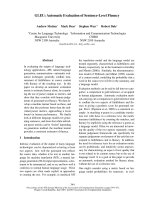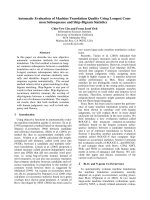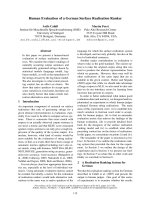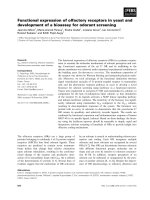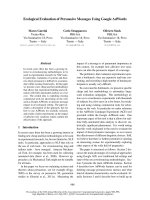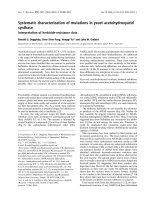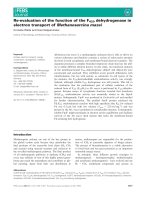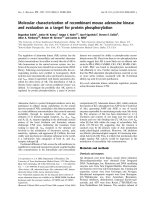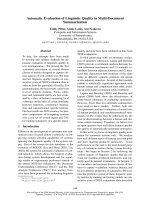báo cáo khoa học: "Systematic evaluation of implementation fidelity of complex interventions in health and social care Henna Hasson1,2,3" pdf
Bạn đang xem bản rút gọn của tài liệu. Xem và tải ngay bản đầy đủ của tài liệu tại đây (274.73 KB, 9 trang )
STUDY PROTO C O L Open Access
Systematic evaluation of implementation fidelity
of complex interventions in health and
social care
Henna Hasson
1,2,3
Abstract
Background: Evaluation of an implementation process and its fidelity can give insight into the ‘black box’ of
interventions. However, a lack of standardized methods for studying fidelity and implementation process have
been reported, which might be one reason for the fact that few prior studies in the field of health service research
have systematically evaluated interventions’ implementation processes.
The aim of this project is to systematically evaluate implementation fidelity and possible factors influencing fidelity
of complex interventions in health and social care.
Methods: A modified version of The Conceptual Framework for Implementation Fidelity will be used as a
conceptual model for the evaluation. The modification implies two additional moderating factors: context and
recruitment. A systematic evaluation process was developed. Multiple case study method is used to investigate
implementation of three complex health service interventions. Each case will be investigated in depth and
longitudinally, using both quantitative and qualitative methods.
Discussion: This study is the first attempt to empirically test The Conceptual Framework for Implementation
Fidelity. The study can highlight mechanism and factors of importance when implementing complex interventions.
Especially the role of the moderating factors on implementation fidelity can be clarified.
Trial Registration: Supported Employment, SE, among people with severe mental illness – a randomized
controlled trial: NCT00960024.
Background
Health service interventions are often highly complex,
compared to efforts like drug trials or trials of surgical
procedures [1]. Health service interventions consist of a
number of components that might act both indepen-
dently and inter-dependently. This can challenge the eva-
luation of the program impact [2]. Experimental studies
that most often are used to evaluate interventions give
little informat ion on why certain effects were or were not
found. In addition, no information is gained on whether
complex interventions were implemented as intended [3].
Thus, there might be a risk in evaluating a program that
was descri bed but not impl emented [4]. For instance, a
classical study by Dobson and Cook [4] regarding a
program for ex-offenders fo und that o nly one in twenty
consumers actually received the program as described in
the methods section. Thus, theoutcomedatacouldnot
be attributed to the prog ram as described. Other studies
examining programs to help people with mental illnesses
obtain employment found that program outcomes
among the intervention groups were weakest for those in
poorly implemented programs [5].
As a result, it has been recognized that aside from
outcome evaluations, it is necessary to gain insight into
the ‘black box’ of interventions [6]. It has been sug-
gested that a process evaluation including information
about program implementation is needed to evaluate
complex interventions [3,7]. A study of intervention
implementation process could impro ve the validity of
intervention findings [6,8,9] and help to explain for
what specific reasons an intervention succeeded or failed
[4]. For instance, studies with a type III error, i.e., a
Correspondence:
1
Lund University School of Economics and Management, Department of
Business Administration, 220 07 Lund, Sweden
Full list of author information is available at the end of the article
Hasson Implementation Science 2010, 5:67
/>Implementation
Science
© 2010 Hasson; licensee BioMed Central Ltd. This is an Open Access article distributed under the terms of the Creative Commons
Attribution License ( which permits unrestricted use, distribution, and reproduction in
any medium, provided the original work is properly cited.
failure to implement a program as planned, could erro-
neously conclude that lack of program impact was due
to attributes of the particular intervention if no process
measures were collected [4]. Process evaluation can also
allow better judgment o f transferability of potentially
effective programs to other settings [1]. However, sev-
eral li terature reviews of intervention research have con-
cluded that few prior studies in the field of health
service research have systematically documented imple-
mentation processes of intervention programs [7,9,10].
In general, a process evaluation examines what the
program is and how it is delivered to the target clients
[11]. Implementation fidelity has been used as a measure
for the degree to which an intervention was implemen-
ted as was intended [12]. These concepts overlap [6],
but the basic idea of both concepts is to compare the
program itself and its actual delivery to a standard of
the program that describes the intended program and
its intended implementation [11]. Several aspects of the
program delivery can be measured. Steckler et al. [13]
defined key components to be included in a process eva-
luation. They suggested that a systematic evaluation
should be done of the procedures that were used to
attract participants (recruitment), the proportion o f
intended clients who actually participated in the pro-
gram (reach), the extent to which participants engaged
in the activities of the program (dose received), the
amount of intended components of the program that
were delivered (dose delivered), the extent to which the
program was implemented as planned (fidelity) , and the
aspects of the context, (i.e., larger social, political, and
economic environm ent that may ha ve influenced imple-
mentation). Other studies have focused more precisely
on the concept of implementation fidelity and suggested
that it can be defined in terms of five elements regard-
ing to what extent the delivered intervention correspond
to the designed intervention (adherence), amount of an
intervention received by participants (exposure or dose),
quality of the program delivery, participants’ engage-
ment in the program activities (participant responsive-
ness), and presence or absence of the critical program
elements (program differentiation) [10,12]. Several
authors have suggested that multiple components need
to be measured in order to achieve a comprehensive
picture of implementation processes and fidelity
[9,12,13]. However, several literature reviews of imple-
mentation fidelity concluded that many prior process
studies have included too few components when analyz-
ing implementation fidelity [10,12]. Most of these stu-
dies have only evaluated adherence, the extent to which
the delivered interventions correspond to the designed
intervention [12], which alone does not give understand-
ing o f factors affecting implementation [9]. It has been
stated that a more standardized methodology for
studying fidelity is needed [12]. Thus, there is a need for
more systematic implementation evaluations that mea-
sure several aspects of an implementation process.
The conceptual framework
Carroll et al. [9] proposed a framework for evaluation of
implementation fidelity, which currently is the most
complete conceptual fram ework for implementation
fidelity. The framework includes components of imple-
mentation fidelity and factors that may influence the
degre e of fidelity, referred to as moderatin g factors. The
measurement of implementation fidelity is a measure-
ment of adherence, with its subcategories – content, fre-
quency, duration, and coverage (dose). Thus, adherence
relates to the content and dose of the intervention, i.e.,
whether the active ingredients of the intervention have
been received by the participants as often and for as
long as was planned. Intervention complexity, facilita-
tion strategies, quality of delivery, and participant
responsiveness were included in the framework as mod-
erating factors. Intervention complexity has been found
to influence the implementation fidelity, i.e., complex
interventions were more difficult to implement with
high fidelity than simple interventions [14]. C omplexity
refers to both description of the intervention and the
real nature of the intervention. Interventions described
in detail are more likely expected to be implemented
with high fidelity than ones with vague descriptions.
Facilitation strategies, such as provision of manuals,
guidelines, training, and feedback, may be used both to
optimize and to standardize implementation fidelity.
However, more facilitation strategies do not necessarily
mean better implementation. Instead facilitation might
be highly dependent on the complexity of the interven-
tion. Quality of deliver y concerns the appropriateness of
the delivery process for achieving what was intended.
Dusenbury et al. [12] defined quality of delivery as ‘the
extent to which a provider approaches a theoretical
ideal in terms of delivering program content.’ Participant
responsiveness refers both to individuals receiving the
intervention and individuals responsible fo r delivering it.
Higher levels of implementation fidelity are assumed to
be achieved if those responsible for delivering an inter-
vention are enthusiastic about it. Similarly, the uptake of
the intervention depends on the responsiven ess of those
receiving it. The authors of the framework suggest that
the moderators have complex relationships to each
other and to the implementation fidelity. For example,
facilitation strategies may improve quality of delivery,
which in turn may influence participants’ commitment
to the intervent ion. However, the potential moderating
effect of intervention complexity makes that impact
more complicated. The authors suggest that there may
be interaction effects between moderators, i.e., when the
Hasson Implementation Science 2010, 5:67
/>Page 2 of 9
effect of one factor is dependent on the level of another.
In summary, the framework suggested that different
moderating factors might affect, positively or negatively,
the implementation process and its fidelity. These fac-
tors interact with each other and the effect of one factor
on fidelity might be influenced by another moderating
factor. The framework suggested that all these factors
should be evaluated systematically when conducting a
process evaluatio n. In this project, two additional mod-
erating factors were included in the framework, namely
context and recruitment. The modified framework is
presented in Figur e 1. I mportance of cont ext for pro-
gram implementation has been highlighted by several
other authors [3,15-17]. Lipsey [3] emphasized the
importance of taking into account surrounding social
systems, such as structures and cultures of organizations
and gro ups, inter-organizational linkages, and historical
as well as con current events, when assessing program
implementation. Pettigrew and Whipp’s [15] model of
strategic change manage ment defined context together
with content and process as main determinants of
change. Recruitment refers to procedures that were used
to attract potential program participants. Baranowski
and Stables [18] argued that recruitment was a key pro-
cess evaluation component. Some of the aspects to be
evaluated were suggested to be reasons for nonparticipa-
tion among potential participants, subgroups that were
less likely to partic ipate, and consistency of recruitment
procedures among potential participa nts. Steckler et al.
[13] argued that an evaluation of recruitment can con-
tribute to correct generalization of findings, i.e., not gen-
eralization results for subgroups that have chosen not to
participate. In this study, the modified framework will
be used as a conceptual model to structure the data col-
lection and analyses to identify mechanism and factors
that might influence the implementation of complex
interventions.
The aim of this project is to evaluate systematically
implementation fidelity and possible factors influencing
fidelity of complex interventions in health and social
care. The purpose is to test the conceptual framework
for implementation fidelity proposed by Carroll et al.
and contribute to the knowledge base of how implemen-
tation fidelity and moderating factors can be evaluated
for complex interventions.
Methods
Design of the study
The multiple case study method will be used to investi-
gate the implementation processes of three intervention
studies. Thus, a case is defined as an intervention study.
Each case will be investigated in depth and longitudin-
ally, using both quantitative and qualitative methods.
The case study method has been proposed to be a suita-
ble method for conducting longitudinal research of
change processes [17,19].
Descriptions of the cases, i.e., interventions
All three interventio ns are complex in nature, including
several act ive ingredients. In addition, t he interventions
are conducted in complex health or social care environ-
ments where several professional groups or care provi-
der organizations cooperate. The three interventions are
briefly described below.
Continuum of care for frail elderly persons, from the
emergency ward to living at home
The intervention involves development, implementation,
and evaluation of an integrated care chain for frail
elderly people. The care chain will cover the older
Intervention
Adherence:
Content
Coverage
Frequency
Duration
Outcomes
Potential moderators:
Participant responsiveness
Comprehensiveness of policy description
Strategies to facilitate implementation
Quality of delivery
Recruitment
Context
Component analysis
to identify
“essential” components
Evaluation of
implementation
fidelity
Evaluation
Figure 1 The modified conceptual framework for implementation fidelity (originally from Carroll et al.).
Hasson Implementation Science 2010, 5:67
/>Page 3 of 9
person’s contacts with community care providers (home
help services, home nursing, and rehabilitation), primary
care, the hospital emergency department and hospital
ward. A case manager and a multi-professional team
will help the elderly people and their relatives to coordi-
nate care contacts. The theoretical framework for the
study is that integrated care with a case manager creates
networks of resources and services over time and
between different healthcare providers, particularly
between health and social care. This is expected to
improve health-related quality of life, increase satisfac-
tion with care and rehabilitation, dec rease older persons’
emergency care consumption, and influence cost effi-
ciency at the community level. The study design is a
randomized controlled study with a total of 200 partici-
pants divided into intervention and control group. The
study is conducted in the city of Mölndal in western
Sweden. The possible effects of the intervention on par-
ticipants’ capability to perform activities, health-related
quality of life, satisfaction with care, and emergency care
consumption will b e evaluated at three, six, twelve and
twenty-four months after the baseline measurement.
The responsible resear chers are Synneve Dahlin-Ivanoff,
PhD (Medicine), Professor and Katarina Wilhelmson,
PhD (Medicine) a t the Sahlgre nska Academy at Göte-
borg University.
Palliative care in community nursing homes for older
people – support for nursing staff
The intervention involves development, implementation,
and evaluation of a support program in palliative care
for nursing staff and workplace leaders working in com-
munity nursing facilities for older people. The support
program is based on a study circle model that combines
participants’ reflections and discussions based on their
expertise and work experiences. The model includes
having participants learn to question their work prac-
tices and de velop new ways of working and solving pro-
blems at work. The program consists of regular
meetings for each professional group and cross-profes-
sional workshops. Reading materials regarding palliative
care and other r elated relevant subjects will be provided
prior to a study circle. An external facilitator will lead
the circles. Participants are expected to get direct sup-
port in terms of improved knowled ge as well as indirect
support in terms of a collective platform for reflections,
discussion, stimulation, and concrete improvement
work. The theoretical framework for the study is that
support in terms of expertise development and coaching
positively affects staff att itudes towards care recipients,
their work satisfaction, and general wellbeing. The inter-
vention is conducted in a quasi-experimental design in
six nursing homes in the city of Malmö in southern
Sweden. The possible effects of the intervention on staff
satisfaction, work climate, and general well-being are
evaluated at six and eighteen months after the baseline
measur ement. The responsible researcher is Anna-Karin
Edberg, PhD (Medicine), Professor, Lund University.
Supported employment among people with severe
mental illness – a randomized controlled trial
The study involves implementation and evaluation of an
evidence-based method, supported employment (SE), for
vocational rehabilitation for people with mental illnesses.
The purpose of SE, according t o the Individual Place-
ment and Support model, is to help people with severe
mental illness find and keep employment in a competi-
tive market. SE has been widely recognized as the most
effective approach to increasing work opportunities for
people with severe mental illness [20-22], but has not
been tested in a Swedish welfare context. This is the
first randomized controlled SE study in Sweden. The
theoretical framework for the study is that work en ables
people to integrate socially and provides them with
opportunities to explore and mas ter their envi ronment
and t hereby become integrated in society. The study is
conducted in the city of Malmö in southern Sweden.
The possible effects of the intervention on clients’ voca-
tional outcomes, such as employment rate and monthly
income, as well as on their non-vocational outcomes,
such as quality of life and sense of empowerment, will
be evaluated at six and eighteen months after the base-
line measurement. The responsible researcher is Ulrika
Beijerholm, PhD (Medicine), Lund University.
The research team
The author of the paper is the principle investigator of
this implementation project. The project is a part of lar-
ger research programs at the Vårdal Institute, where the
three above-mentioned intervention projects are also
being conducted. The responsible researchers mentioned
above are responsible for designing, conducting, and
evaluating the impact of the intervention studies. Thus,
the investigation of implementation process and its fide-
lity is conducted by other researchers than those
involved in the develo pment of the interventions. How-
ever, some data collec tion is conducted in collaboration
so that participants and other stakeholders need not
experience excessive burdens with interviews, question-
naires, and observations.
The evaluation plan
An overall process evaluation plan was developed for
this project. This is presented in Table 1. In addition,
more detailed evaluation plans for each intervention
study were created (see additional files 1, 2 and 3). The
modified framework for implementation fidelity was
used to define the areas to be measured. These are
Hasson Implementation Science 2010, 5:67
/>Page 4 of 9
presented at the first column of Table 1. Steckler et al.’s
[13] stepwise approach to designing a process evaluation
was used as a tool for planning the practical steps in the
evaluation process. In accordance with the approach,
first a description of the actual program and its theoreti-
cal basis, purpose, core inputs, and expected outcomes
was made. This description was summarized in a logic
model. Separate logic models were created for each of
the three intervention studies. As an example, the logic
model for the Continuum of care for frail elderly per-
sons, from the emergency ward to living at home inter-
vention project is presented in Table 1.
In the second step, a detailed description of the com-
ponentsoftheprogramswascreated.Atthisstage,
each component of the intervention and its intended
delivery was described as these were stated in a pro-
gram plan. Also, the content and delivery of the pro-
gram for the control group was described. Amount of
intervention services and frequency of delivering these
services were described in detail. Table 2 presents the
delivery process of the Continuum of care for frail
elderly persons, from the emergency ward to living at
home intervention.
In the third stage, general process questions were
developed (second column in Table 3). One to three
questions were developed for each fidelity component
and potential moderating factor. For instance, subcate-
gories of fidelity are measured through q uestions: ‘Was
each of the intervention components implemented a s
planned?,’‘Were the intervention components imple-
mented as often and for as long as planned?’ and
‘What proportion of the target group participated in
the intervention?.’ To measure participant
responsiveness, three questions were developed: ‘How
did the participants become engaged in the interven-
tion services?,’‘How satisfied were the p articipants
with the intervention services?’ and ‘How did the parti-
cipants perceive the outcomes and relevance of the
intervention?.’ After developing the general process
questions, more specific questions for each of the
intervention projects were developed. These are
described in a dditional files 1, 2 and 3.
Data collection and analyses
Data will be collected for each of the three intervention
studies during the entire intervent ion period. A mult i-
method approach will be us ed. Data collection methods
include key informant interviews, non-participant obser-
vations, questionnaire studies, analysis of participants’
logbook s, and other document analysis. The data collec-
tion methods for answering each of the process ques-
tions are described in the third column in Table 3. For
instance, observations of work practices, project leaders’
logbooks and interviews with project leaders, partici-
pants, and o ther relevant stakeholders will be used to
answer the que stions concerning implementation fide-
lity. In addition, in the third intervention a previously
developed and validated instrument, Supporte d Employ-
ment Fidelity Scale [23], is used to evaluate implementa-
tionfidelity.Toevaluate adequacy of strategies to
facilitate the implementation, process interviews with
the relevant stakeholder will be conducted and question-
naire items will be added in follow-up questionnai res to
intervention participants. To measure the complexity of
the intervention programs, a group of external research-
ers will be used. Contextual factors will be measured
Table 1 The logic model of Continuum of care for frail elderly persons, from the emergency ward to living at home
intervention
Core inputs Immediate Impacts Short-Term Impacts Impacts Health Outcomes
Geriatric
assessment at
emergency
department,
Contact between emergency
department and community case
manager,
Community care will have
increased information regarding
the needs of the older person,
increased contact between
emergency healthcare and
community social care,
Possibilities for earlier discovery
of problems, earlier care and
rehabilitation efforts and
changes in care and
rehabilitation plans, better
uptake of older people’s
viewpoints
Maintained functional
ability, increased life
satisfaction, reduced
number of visits to the
emergency department,
Case manager
and multi-
professional
team at the
community
care,
Case manager has early contact
with older person at hospital,
continuous contact between case
manager and older people, early
contact with older peoples’
families
Reduced number of
stays in hospital wards,
higher satisfaction with
community care and
rehabilitation
Care planning
after hospital
discharge at
older person’s
home
Older people will have more
knowledge of whom to contact
when they need help, increased
participation opportunities for
older people and their families in
care planning
Hasson Implementation Science 2010, 5:67
/>Page 5 of 9
with interviews, logbooks, and questionnaire items. For
instance, in the Palliative Care In Community Older
People Nursing Homes – Support For Nursing Staff
project, a previously validated questionnaire, the Dimen-
sions of the Le arning Organizatio n Questionnaire
[24,25], will be translated to Swedish and used to mea-
sure participants’ perceptions of learning culture in their
organizations. More detailed descriptions of data collec-
tion methods for each of the intervention studies are
presented in additional files 1, 2 and 3.
Some data collection such as interviews and observa-
tions will be conducted in collaboration with other
researchers focusing on process aspects at the Vårdal
Institute. This is done to minimize the load for respon-
dents and to best use the resources of the researchers.
Content analysis o f the qualitative data, i.e., logbooks,
interviews, observations, and document material will be
conducted. As has been suggested [26], a coding scheme
will be created and tested prior to the a nalyses. Results
from the questionnaire surveys will be analyzed with
both descriptive and analytical methods. Results of the
surveys enable analyses regarding variations within the
intervention group and its possible relationship with
outcome variables. For instance, users’ participation in
Table 2 Planned delivery of the Continuum of care for frail elderly persons, from the emergency ward to living at home
Intervention
INTERVENTION GROUP
Emergency
department
A nurse with geriatric expertise makes an assessment of the elderly patients’ needs of rehabilitation, nursing, and geriatric
care.
For participants who are admitted to the hospital ward, the geriatric assessment is transferred to the ward nurses.
The case manager and the multi-professional team in the community are informed that the patient has visited the
emergency care, and whether he/she was transferred to a hospital ward or returned home.
The geriatric assessment is sent to the case manager and the multi-professional team in the municipality.
Hospital ward The community case manager is responsible for contacting the ward and the elderly person.
The case manager visits participants in the ward, if necessary, contacts the participants’ relatives, and initiates support for
relatives if necessary.
The case manager continues to have contact with the hospital ward so that discharge planning can start early.
Discharge planning is done in collaboration between the case manager, a qualified social worker, the patient, as well as the
nurse and physician in charge at the ward.
Community care The case manager contacts participants returning home after visiting the emergency department and offers care planning.
She also initiates support for patients’ relatives if necessary.
The case manager and the multi-professional team make a care plan a couple of days after discharge from the hospital ward.
Care planning is done at the older person’s own home instead of in the hospital ward, which is the traditional model.
The care plan is based on the results in the geriatric assessment made at the emergency department. Further assessment is
made regarding patients’ functional abilities, health status, diseases, and ongoing and planned treatment and care. All
planning is done in consultation with the patient.
The multi-professional team informs other professionals and care providers, such as home help services and home nursing
care, regarding the plan made.
The case manager follows up the care plan within a week, via telephone or home visit, to ensure that everything is working
and no new problems have arisen.
The participants are advised that the case manager is available for questions, problem solving, and assistance during office
hours.
The case manager has telephone contact with participants once a month except in cases where more frequent contact is
needed.
Primary care Patient’s general practitioner is informed by letter that the individual is participating in the research project. Information is
given regarding content of the project, i.e., the role of the case manager, and her contact information.
The control group receives traditional care that differs from the intervention in the following aspects:
CONTROL GROUP No nurse with geriatric expertise available at the emergency department, which implies that no geriatric assessment is made.
No case manager or multi-professional team available, which implies among other things that the community is not
informed if an older person has visited emergency department. Nor is the community informed when older people have
been hospitalized in a ward if these people do not have community home help services or nursing care. It implies also that
the elderly people do not have a one single contact person; instead they contact different care organizations when needed.
For patients being hospitalized, a care plan is made at the hospital ward by the community social worker, community nurse,
and rehabilitation staff when necessary.
Follow-up of the care plan is done at patient’s home by care providers, i.e., home help providers or home nursing providers.
No follow-up for individuals who don’t receive home help or home nursing.
Hasson Implementation Science 2010, 5:67
/>Page 6 of 9
the program can be studied in relation to their results in
the follow-up outcome measurements.
Ethical approval
Data collection in this project was included in the ethi-
cal applications of the intervention projects. Ethical
approvals have been granted for the first intervention
study: (Gothenburg University dossier number 413-08)
andthethirdinterventionstudy(LundUniversitydos-
sier number 202/20 08). For the second study, an ethical
application was sent to the research ethics committee at
Lund University. The committee reported that the y
didn’t identify any ethical hinders for conducting the
study (dossier number 2009-527), but made a decision
that in accordance with legislation no formal ethical
approval was needed for the study.
Discussion
The aim of this project is to systematically evaluate
implementation fidelity and possible factors influencing
fidelity of complex interventions in health and social
care. The intention is to empirically test the conceptual
framework for implementation fidelity proposed by Car-
roll et al. [9]. The framework was modified in such a
way that two additional moderating factors, context and
recruitment, we re included in the framework. The pur-
pose is to contr ibute to the knowledge base on develop-
ment of systematic evaluation of implementation of
Table 3 The general evaluation plan including areas to measure, general process questions, data sources and data
collection methods
Areas to measure General process questions Data source and data collection method
Evaluation of adherence
Content Was each of the intervention components implemented as planned? - observations of work practices
- project leaders’ logbooks
- interviews with stakeholders and
participants
- Intervention 3: a previously developed and
validated instrument IPS-fidelity scale will be
used
Frequency/Duration
(Dosage, Dose delivery)
Were the intervention components implemented as often and for as long
as planned?
- observations of work practices
- project leaders logbooks
- interviews with stakeholders and
participants
Coverage (Reach) What proportion of target group participated in the intervention? - interviews with project leaders and other
relevant stakeholders
Potential moderating factors
Participant
responsiveness (Dose
received)
How were the participants engaged with the intervention services?
How satisfied were the participants with the intervention services?
How did the participants perceive the outcomes and relevance of the
intervention?
- project leaders’ logbooks
- interviews with project leaders and
participants
- questionnaire items to participants
included in the follow-up measurements
Intervention complexity How complex is the intervention? - a group of external researchers will
evaluate the intervention complexity
Comprehensiveness of
policy description
How specific is the interventions description? - a group of external researchers will
evaluate the comprehensiveness of policy
description
Strategies to facilitate
implementation
What strategies were used to support implementation?
How were these strategies perceived by staff involved in the project?
- interviews with project leaders, participants
and other relevant stakeholders,
- questionnaire items to participants
included in the follow-up measurements
Quality of delivery How was the quality of delivering the intervention components? - interviews with project leaders and
participants,
- observations of work practices
Recruitment What recruitment procedures were used to attract individuals to the
intervention? What constituted barriers to maintaining involvement of
individuals?
- interviews with those who recruited the
participants
- interviews with project leaders and
participants
Context What factors at political, economical, organizational, and work group levels
affected the implementation?
- interviews with project leaders, participants,
and other relevant stakeholders
- project leaders’ logbooks
- questionnaire items to participants
included in the follow-up measurements
Hasson Implementation Science 2010, 5:67
/>Page 7 of 9
complex interventions. This will highlight the mechan-
ism and factors of importance when implementing com-
plex interv entions. Especially the role of the moderating
factors influencing implementation will be clarified.
The study also present s a practical example of how to
develop a systematic process evaluation for complex
interventions. The results of this study can be used to
interpret the results of the outcome evaluation of the
interventions. Information will be gained on how, when,
and in what context the interventions work. This infor-
mation can be used for practical future program
planning.
Some practical issues relevant to the conducting of
this study will be briefly discuss ed. First, these interven-
tions are conducted in local practices, but in a research
context. Programs implemented as part of research pro-
jects usually receive considerable support to achieve
high fidelity [12]. Outside of research context, imple-
mentation usually takes place in less ideal circumstances
[10]. Thus, it is possible that the factors af fecting imple-
mentation and its fidelity in this project are not totally
comparable to real-life situations. Nonetheless, as Dane
and Schneider [10] point out, understanding fidelity
under the research conditions is crucial for a f ield of
practice to advance. The next step would be to study
the implementation of these programs aft er the research
program.
The thre e intervention studies included in the proje ct
represent different type of health service interventions.
This will offer an opportunity for cross-case comparison
of different interventions. Knowledge will be gained
regarding each type of intervention specific, and more
general knowledge will be obtained when comparing the
cases. The strength of using a case study design lies in
the opportunity to collect multiple types of data,
enabling development of a comprehensive, in- depth pic-
ture of the implementation processes.
A process eval uation often requires a large amount of
data collection, which makes it time-consuming and
expensive. This project offers an example of how colla-
boration between different researchers within a large
project can enable collection of process data. The colla-
boration with data collection enables a rich data mate-
rial. For instance, stakeholder interviews and worksite
observations will be conducted in collaboration with
other researchers. In addition, questions regarding parti-
cipants’ experiences of the program implementation will
be included in follow-up outcome evaluation question-
naires i nstead of conducting separate questionnaire sur-
veys or participant interviews. Using results of
interviews that have been conducted by other research-
ers might have some limitations, such as not obtaining
primarysourceinformation.Ontheotherhand,the
positive factors concerning time, resources, and respon-
dent burden were considered to carry more weight.
Inanytypeofprocessanalysis,achoicehastobe
made regarding what data should be collected. On one
hand, sever al imp lementation process components need
to be measured to be able to understand the process [9].
On the other hand, for practical r easons a selection of
collected data needs to be made. The study presents a
systematic way of evaluating implementation fidelity and
factors potentially affecting fidelity. However, the study
does not cove r all potential factors influencing imple-
mentation of comple x interventions. This is an attempt
to measure t he most essential components identified in
the prior studies. The goal is that this study can contri-
bute to knowledge of what factors should be included in
future process evaluations.
Additional material
Additional file 1: A process-evaluation plan for the Continuum of
care for frail elderly persons, from the emergency ward to living at
home.
Additional file 2: A process-evaluation plan for Palliative care in
community older people nursing homes - support for nursing staff.
Additional file 3: A process-evaluation plan for the Supported
Employment (SE) among people with severe mental illness - a
randomized controlled trial. the files include detailed evaluation plans
for each intervention study.
Acknowledgements
The author would like to thank research colleagues at the Vårdal Institute
(The Swedish Institute for Health Sciences), who have on several occasions
reviewed the draft of the project plan. The Vårdal Institute finances this
project and the three intervention projects. In addition, the Continuum of
care for frail elderly persons, from the emergency ward to living at home
intervention has received funding from the Vinnvård research program. The
Supported Employment, Se, Among People With Severe Mental Illness – A
Randomized Controlled Trial has received funding from the Swedish Council
for Working Life and Social Research (FAS) and a regional Finsam
organization (a local association of cooperation between municipality,
county council, social insurance office and the public employment office).
Author details
1
Lund University School of Economics and Management, Department of
Business Administration, 220 07 Lund, Sweden.
2
Vårdal Institute, Swedish
Institute for Health Sciences, 221 00 Lund, Sweden.
3
Karolinska Institutet,
Department of Learning, Informatics, Management and Ethics, Medical
Management Centre (MMC), 171 77 Stockholm, Sweden.
Competing interests
The author declares that they have no competing interests.
Received: 22 June 2010 Accepted: 3 September 2010
Published: 3 September 2010
References
1. Bradley F, Wiles R, Kinmonth AL, Mant D, Gantley M: Development and
evaluation of complex interventions in health services research: case
study of the Southampton heart integrated care project (SHIP). The SHIP
Collaborative Group. Bmj 1999, 318:711-715.
Hasson Implementation Science 2010, 5:67
/>Page 8 of 9
2. Medical Research Council: A framework for development and evaluation of
RCTs for complex interventions to improve health London: MRC 2000.
3. Lipsey MW, Cordray DS: Evaluation methods for social intervention.
Annual review of psychology 2000, 51:345-375.
4. Dobson D, Cook TJ: Avoiding type III error in program evaluation: Results
from a field experiment. Evaluation and Program Planning 1980, 3:269-276.
5. McGrew JH, Griss ME: Concurrent and predictive validity of two scales to
assess the fidelity of implementation of supported employment.
Psychiatric rehabilitation journal 2005, 29:41-47.
6. Hulscher M, Laurant MGH, Grol R: Process evaluation on quality
improvement interventions. Quality and Safety in Health Care 2003,
12:40-46.
7. Fixsen DL, Naoom SF, Blase KA, Friedman RM, Wallace F: Implementation
research: A synthesis of the literature Tampa, FL: University of South Florida,
Louis de la Parte Florida Mental Health Institute, The National
Implementation Research Network (FMHI Publication 231) 2005.
8. Campbell M, Fitzpatrick R, Haines A, Kinmonth AL, Sandercock P,
Spiegelhalter D, Tyrer P: Framework for design and evaluation of complex
interventions to improve health. Bmj 2000, 321:694-696.
9. Carroll C, Patterson M, Wood S, Booth A, Rick J, Balain S: A conceptual
framework for implementation fidelity. Implementation Science 2007, 2:40.
10. Dane AV, Schneider BH: Program integrity in primary and early secondary
prevention: are implementation effects out of control? Clinical Psychology
Review 1998, 18:23-45.
11. Rossi PH, Lipsey MW, Freeman HE: Evaluation: A systematic approach Sage
Publications Inc 2004.
12. Dusenbury L, Brannigan R, Falco M, Hansen WB: A review of research on
fidelity of implementation: implications for drug abuse prevention in
school settings. Health Education Research 2003, 18:237-256.
13. Steckler AB, Linnan L, Israel BA: Process evaluation for public health
interventions and research Jossey-Bass 2002.
14. Greenhalgh T, Robert G, Macfarlane F, Bate P, Kyriakidou O: Diffusion of
innovations in service organizations: systematic review and
recommendations. Milbank Q 2004, 82:581-629.
15. Pettigrew AM: Longitudinal field research on change: theory and
practice. Organizational Science 1990, 1:267-292.
16. Pettigrew AM: The character and significance of strategy process
research. Strategic Management Journal 1992, 13:5-16.
17. Pettigrew AM: What is a processual analysis? Scandinavian Journal of
Management 1997, 13:337-348.
18. Baranowski T, Stables G: Process evaluations of the 5-a-day projects.
Health Education & Behavior 2000, 27:157-166.
19. Yin RK: Case Study Research: Design and Methods Sage Publications Inc 2003.
20. Bond GR, Drake RE, Becker DR: An update on randomized controlled trials
of evidence-based supported employment. Psychiatric rehabilitation
journal 2008, 31:280-290.
21. Burns T, Catty J, Becker T, Drake RE, Fioritti A, Knapp M, Lauber C, Rössler W,
Tomov T, Van Busschbach J: The effectiveness of supported employment
for people with severe mental illness: a randomised controlled trial. The
Lancet 2007, 370:1146-1152.
22. Campbell K, Bond GR, Drake RE: Who Benefits From Supported
Employment: A Meta-analytic Study. Schizophrenia Bulletin 2009.
23. Swanson S, Bond GR, Merrens MR: Evidence-based Supported Employment
fidelity review manual Dartmouth Psychiatric Research Center 2008.
24. Yang B: Identifying valid and reliable measures for dimensions of a
learning cultur Advances in Developing Human Resources 2003, 5:152-162.
25. Yang B, Watkins KE, Marsick VJ: The Construct of the Learning
Organization: Dimensions, Measurement, and Validation. Human Resource
Development Quarterly 2004, 15:31-55.
26. Weber RP: Basic content analysis Sage Publ, Second edition 1990.
doi:10.1186/1748-5908-5-67
Cite this article as: Hasson: Systematic evaluation of implementation
fidelity of complex inte rventions in health and social care.
Implementation Science 2010 5:67.
Submit your next manuscript to BioMed Central
and take full advantage of:
• Convenient online submission
• Thorough peer review
• No space constraints or color figure charges
• Immediate publication on acceptance
• Inclusion in PubMed, CAS, Scopus and Google Scholar
• Research which is freely available for redistribution
Submit your manuscript at
www.biomedcentral.com/submit
Hasson Implementation Science 2010, 5:67
/>Page 9 of 9

